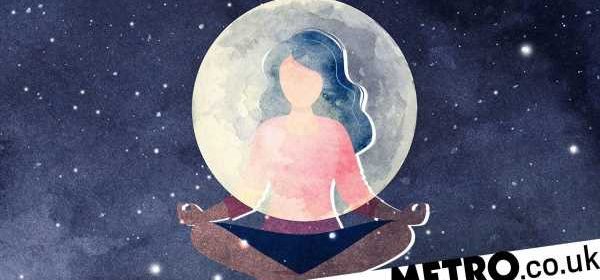Try this hip-opening, Full Moon yoga sequence to release emotions


Tonight, we’ll be graced with 2023’s first Full Moon.
For many, the full moon has spiritual significance and is a great time to reflect and heal.
And, for the astrology-minded, this month’s Wolf moon is in Cancer, which means it could bring up some hefty emotions.
‘This Full Moon blends beautifully with the energies of Cancer and with the Sun in Capricorn, but it could make you feel emotional if there is an imbalance occurring in your world,’ spiritual coach Samantha Jayne tells Metro.co.uk.
To help to release some of these emotions, yoga teacher and founder of The Soul Sanctuary, Cat Meffan, recommends a hip-opening yoga flow.
Why focus on the hips?
The body is known for storing our emotions physically and, in neuroscience and somatics studies, the hips are often pointed to as one of the most common emotional vessels in the body.
‘On an energetic level this area of the body relates to our creativity, a space of ideas coming together, relationships, expression, sensuality and sexuality,’ says Cat.
‘Even just reading that list, it’s no wonder that many people find themselves going on an emotional rollercoaster in a hip-opening class.
‘And sometimes it won’t be obvious in the moment, the emotion may take a while to arise, which is why we can find ourselves confused when feeling emotional days after a class.’
Not everyone experiences an emotional release during a hip-opening sequence but if you’re feeling particularly stuck – both physically and mentally – it might be a good time to give it a try.
Warm up before performing each pose, one by one, to complete the flow. Repeat the sequence as many times as you need.
Pigeon Pose (Kapotasana)

Sit with your right bum cheek on a yoga block to create more space for the hips, bend the right leg out in front of you with the lower leg coming in at an angle – it does not need to be at 90 degrees, just find the angle that feels best for you.
The left leg is straight out behind you with the top of the foot planting into your mat.
Use the hands to support either side of your body, take an inhale creating space and length in the torso, then if it feels good to, fold forwards by hinging at the hips, trying to keep the spine long.
Hold for five to 10 deep breaths and repeat on the other side.
Cow Face Pose (Gomukhasana)

Sitting on a block may be useful for this shape, to give more space for the hips.
Bend one leg out in front of you with the foot coming back in, and then do the same with the other leg on top, stacking the knees on top of each other.
If this is not available to you, a cross-legged seated shape (sukhasana) is a lovely way to feel the same lower body activation.
For Gomukhasana you can just do the legs with a forward fold, or take the full expression by finding a tricep stretch in the upper body.
For this, the opposite arm to the top leg reaches up and over the back, and the other arm reaches behind to clasp the hands.
Hold for five to 10 deep breaths and repeat on the other side.
Goddess Pose (Utkata Konasana)

Stand with the legs wide and the toes turned outwards on a diagonal.
Lower the hips down into a wide squat while externally rotating the thighs from the hip joint, making sure the knees don’t fall inwards.
Here we are strengthening the glutes, quads and inner thighs, while opening the hips.
Try to keep the pelvis as neutral as possible, without pushing the bum too far back.
Play around with different arm variations in this shape.
Hold for five to 10 deep breaths.
Side Lunge (Skandasana)

Stand with your legs wide (similar to Goddess) and move over to the right side, bending the right knee and straightening the left.
If your right heel doesn’t reach the mat, roll up a blanket to place under it, or prop your heel up on a block.
You can also keep your hands on the mat to support your balance, or take a high side-lunge variation instead.
Skandasana is an intense hip opening shape, drawing awareness into our fluid water energy and activating the sacral chakra.
Hold for five to 10 breaths and repeat on the other side.
Source: Read Full Article